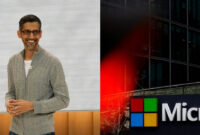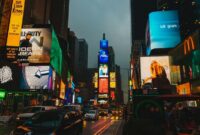After seeing the device in action at WWDC, my colleague Lauren Goode wrote this week, “Every successful Apple product of the past two decades has disappeared into our lives in some way—the iPhone into our pockets, the iPad into our purses, the Apple Watch living on our wrists, and the AirPods resting in our ears.” The Vision Pro, however, differs from nearly every other contemporary Apple device in one key way: It doesn’t vanish. As opposed to that, the device, according to Goode, settles onto your face and covers your eyes, which are “sensory organs that are a crucial part of the lived human experience.” She recognized that this was true of all virtual reality headsets and augmented reality glasses, but the Vision Pro was unique in that it was the first time an Apple product had so significantly impacted people’s lives.
I fully embraced my doomer status after reading Lauren’s evaluation of Vision Pro. It emphasizes the fact that an Apple headset is still a large, obtrusive device placed between its wearer and the outside world, acting more as a barrier than a conduit, regardless of how cool its specifications may be.
Vision Pro is the most recent in a long line of high-profile, eye-catching headgear intended to make augmented reality, virtual reality, or both accessible to the general public, despite Apple’s framing it as disruptive. Its predecessors include Google Glass, Microsoft’s HoloLens, Magic Leap 2, and Meta’s Quest Pro—four highly anticipated headsets that were touted as paradigm-shifting yet all fell short.Without a question, the most recent and sophisticated version of the concept is Vision Pro. It still has to overcome the same obstacle that has hampered every VR and AR headset that came before it: the issue with alternative reality headsets.
As my colleague Boone Ashworth recently noted, there is substantial evidence that people do not want to spend a lot of time wearing this type of device, for a variety of reasons, including aesthetic (snorkel mask for dorks), practical (burdensome, activity-limiting), and social (it’s an isolation chamber you slide over your eyes to experience an individual simulacrum of the world rather than our shared reality).The very simple fact that there simply isn’t a market for daily-use headsets has already harmed the reception of the Vision Pro; instead of the usual rapturous public response to a major new Apple announcement, this time around there was a lot of skepticism, as many people pointed out that the VR/AR market is already rife with big-named failures.
Even the more optimistic reviews of Vision Pro frequently rely on the justification that Apple makes hardware that is simply too excellent to fail. It’s a cool IT firm, not just another typical one. For instance, Kevin Roose of The New York Times speculated, “It’s possible that the market was simply waiting for Apple to show up.”
Even if the niche item in question is kind of ridiculous, Apple has an indisputably impressive history of transforming formerly niche gadgets into ubiquities.
I have AirPod Pros, and I wear them for about five hours a day despite the fact that they irritate my ears and that I constantly washing them by accident. However, there was absolutely nothing wrong with the traditional wired headphones that came with an iPhone in the past. Apple’s impact! Except for parents traveling with young children, no one in this big, wide globe really needs an iPad, but they’re nevertheless hugely popular. Once more, Apple’s influence Apple would undoubtedly be a top contender if any business could make mixed-reality VR/AR headsets appear appealing for daily usage.
But since Apple isn’t the same firm it once was, that would be its hardest lift to yet. When was the last game-changing new Apple product introduced, the kind that becomes a regular fixture? Certainly not since Jony Ive’s departure in 2019. In 2016, it may have been AirPods. Apple has a good track record, yeah. However, AirPods were released seven years ago. The company’s best days are now competing with different rivals, and the path it must take to succeed in this area is much more difficult than persuading college students that stupid Bluetooth earbuds that are seriously so easy to accidentally put through the washing machine are better than wired headphones that never need charging.
Even Apple staff members have expressed skepticism regarding Vision Pro for a reason: No matter how the execution is done, it would be challenging to pull off because it is conceptually difficult to market. Even worse, there are problems with the execution. Maybe if Apple had figured out how to create a mixed reality headgear that weighed only four ounces or worked more like a typical pair of glasses. However, at the moment, it only provides a little sleeker improvement to a type of headgear that is rather uncool-looking. The nerd glasses appear to be nerd glasses.
We are currently in a time where major actors in the tech industry often and drastically make mistakes. Consider FTX. NFTs, or. or the current collapse of crypto. Or the entire flailing metaverse pivot by Meta. This yassified Oculus is evidence that even Apple can make mistakes, proving that Big Tech and its major players are not infallible. One can only hope that Vision Pro’s certain failure will help the company focus on real innovation rather than this dismal step into gimmickry.






